
Catalog excerpts

Temperature Liquid Analysis Registration Systems Services Components Technical Information Tophit CPS491 and CPS491D ISFET Sensor for long-term stable pH measurement in media with high dirt loads Analog or digital sensors with Memosens technology €> <e><0-APPROVED Application ■ Process applications with: - Quickly changing pH values - Alternating temperatures and pressures ■ Water purification and wastewater ■ Media with high dirt loads: - Solids - Emulsions - Precipitation processes With ATEX, FM and CSA approval for application in hazardous areas Your benefits ■ Resistant to breaking - Sensor body made completely of PEEK - Direct installation into the process, reduces effort and costs for sampling and laboratory analysis ■ Double-chamber reference system: - poisoning resistant - polyacrylamide free gel ■ Application possible in heavily soiled media ■ Application possible at low temperatures - Short response time - Constantly high accuracy ■ Longer calibration intervals than glass electrodes - Lower hysteresis with alternating temperatures - Low measuring error after high-temperature loading - Almost no acid and alkaline errors ■ With built-in temperature sensor for effective temperature compensation Further benefits offered by Memosens technology ■ Maximum process safety through contactless inductive signal transmission ■ Data safety through digital data transmission ■ Easy handling thanks to storage of sensor-specific data in the sensor ■ Predictive maintenance possible thanks to registration of sensor load data in the sensor People for Process Automati
Open the catalog to page 1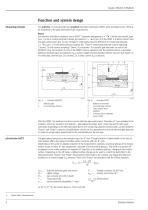
Function and system design Measuring principle Ion-selective, or more generally ion-sensitive field effect transistors (ISFET) were developed in the 1970s as an alternative to the glass electrode for pH measurement. Basics Ion-selective field effect transistors use an MOS 1) transistor arrangement (→ å 1) where the metallic gate (pos. 1) is not a control electrode. Instead, the medium (→ å 2, pos. 3) in the ISFET is in direct contact with the gate isolator layer (pos. 2).Two strongly N-conducting areas are diffused in P-conducting substrate (→ å 2, pos. 5) of the semiconductor material...
Open the catalog to page 2
Important characteristics of Tophit CPS491 • Resistance to breaking This is the most obvious feature of the sensor. The complete sensor technology is embedded in a PEEK shaft. Only the highly resistant isolator layer and the reference have direct contact with the medium. • Acid or alkaline errors A further, important benefit compared with the glass electrode is the considerably reduced number of acid or alkaline errors in extreme pH ranges. In contrast to glass electrodes, practically no foreign ions can build up at the ISFET gate. The measuring error of < 0.01 pH (between pH 1 and 13) at...
Open the catalog to page 3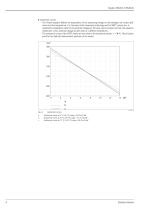
• Isothermic curves – The Nernst equation defines the dependence of the measuring voltage on the hydrogen ion content (pH value) and the temperature. It is the basis of pH measuring technology and for ISFET sensors too. A temperature-dependent value for the potential change per pH value can be worked out from this equation (isothermic curve, potential change per pH value at a defined temperature). – The isothermic curves of the ISFET sensor are very close to the theoretical values (→ å 4). This is further proof for the high pH measurement precision of the sensor. Isothermic curves...
Open the catalog to page 4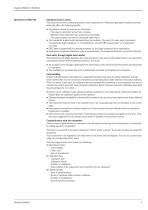
Maximum process safety The inductive and non-contacting measured value transmission of Memosens guarantees maximum process safety and offers the following benefits: • All problems caused by moisture are eliminated. – The plug-in connection is free from corrosion. – Measured value distortion from moisture is not possible. – The plug-in system can even be connected under water. • The transmitter is galvanically decoupled from the medium. The result: No more need to ask about "symmetrically high-impedance" or "unsymmetrical" (for pH/ORP measurement) or an impedance converter. • EMC safety is...
Open the catalog to page 5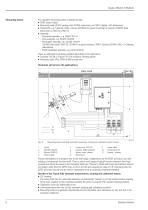
Measuring system The complete measuring system comprises at least: • ISFET sensor Tophit • Measuring cable CPK12 (analog, with TOP68 connection) or CYK10 (digital, with Memosens) • Transmitter, e.g. Liquiline CM4x, Liquisys CPM223 (for panel mounting) or Liquisys CPM253 (field instrument) or Mycom CPM153. • Assembly – Immersion assembly, e.g. Dipfit CPA111 – Flow assembly, e.g. Flowfit CPA250 – Retractable assembly, e.g. Cleanfit CPA471 (CPA450 only with CPS471D, CPS491D or special versions CPS471-ESA and CPS491-ESA, --> Ordering information) – Fixed installation assembly, e.g. Unifit...
Open the catalog to page 6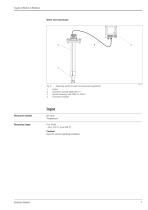
Measuring system for water and wastewater applications Tophit Immersion assembly Dipfit CPA111 Special measuring cable CPK12 or CYK10 Transmitter Liquiline Input Measured variable Measuring range 0 to 14 pH –15 to 110 °C (5 to 230 °F) Caution! Note the process operating conditions.
Open the catalog to page 7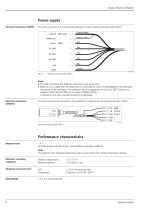
Power supply Electrical connection CPS491 The sensor is connected to the measuring transmitter using the special measuring cable CPK12. Special measuring cable CPK12 Note! • The cable cors Yellow and White are connected on the sensor side. • Make sure you comply with the instructions for connecting the sensor (wiring diagram) in the Operating Instructions of the transmitter. The transmitter has to be appropriate for the use of ISFET sensors (e.g. Liquiline CM42, Mycom CPM153 or Liquisys CPM223/253-IS). A transmitter with only a standard pH input is inappropriate. Electrical connection...
Open the catalog to page 8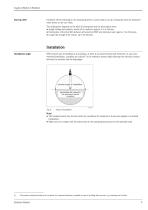
Start-up drift Everytime when switching on the measuring device a control loop is set up. During this time the measured value moves to the true value. The settling time depends on the kind of interruption and the interruption time: • Supply voltage interruption, sensor left in medium: approx. 3 to 5 minutes • Interruption of the fluid film between pH sensitive ISFET and reference lead: approx. 5 to 8 minutes • Longer dry storage of the sensor: up to 30 minutes Installation Installation angle ISFET sensors can be installed in any position, as there is no liquid internal lead. However, in...
Open the catalog to page 9All Endress+Hauser AG catalogs and technical brochures
-
FTL41
3 Pages
-
FTL51B
6 Pages
-
FMG50
10 Pages
-
PTP31B
3 Pages
-
Proline Promass E 300
13 Pages
-
CUS71D
3 Pages
-
iTEMP TMT162
3 Pages
-
CLS54D
3 Pages
-
CLS50D
3 Pages
-
FMX21
5 Pages
-
Liquipoint FTW23
3 Pages
-
Deltapilot FMB50
7 Pages
-
iTHERM TM401
3 Pages
-
COS61D
3 Pages
-
Proline Promag 10W
4 Pages
-
Proline Promag 10P
4 Pages
-
Liquiphant FTL51
6 Pages
-
FMD72
5 Pages
-
PMP51
7 Pages
-
Cerabar PMC51
7 Pages
-
Cerabar PMP75
8 Pages
-
Proline t-mass B 150
4 Pages
-
Proline Prosonic Flow 93P
5 Pages
-
Proline Prosonic Flow 92F
4 Pages
-
FMD78
8 Pages
-
PMD75
10 Pages
-
FMI51
4 Pages
-
FMU30
7 Pages
-
FMP57
4 Pages
-
FMP55
4 Pages
-
FMP54
5 Pages
-
FMP51
5 Pages
-
FMP50
4 Pages
-
FMR52
4 Pages
-
FMR51
5 Pages
-
F 200
13 Pages
-
D 200
12 Pages
-
E 100
5 Pages
-
C 200
11 Pages
-
Tophit CPS471 and CPS471D
20 Pages
-
B_unit4_1
1 Pages
-
B_unit3_3
1 Pages
-
B_unit3_2
1 Pages
-
Wort cooler
1 Pages
-
Condumax CLS16 and CLS16D
14 Pages
-
Condumax CLS16D/CLS16
16 Pages
-
Competence in Oil and Gas
30 Pages
-
Pressure Transducer CT40
24 Pages
-
Liquiphant T FTL20
20 Pages
-
Gammapilot M FMG60
48 Pages
-
Deltabar S PMD70
96 Pages
-
Deltapilot S FMB70
56 Pages
-
Liquicap T FMI21
40 Pages
-
Prosonic S FDU91
40 Pages
-
Levelflex M FMP40
72 Pages
-
Micropilot FMR50
76 Pages
Archived catalogs
-
System components
20 Pages
-
Flow Measurement
32 Pages






























































































